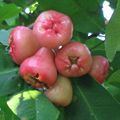Cookbook:Wax Apple – Wikibooks, open books for an open world
Cookbook | Recipes | Ingredients | Fruit
The Wax Apple (proper name Syzygium samarangense) is native to the Philippines, India, Indonesia and Malaysia. Other names include love apple, java apple, bellfruit. water apple, mountain apple and rose apple
The fruit is bell-shaped edible, with colors ranging from white, pale green, green, red, purple, crimson, to deep purple or even black, 4-6 cm long in wild plants. When mature, the tree is considered a heavy bearer and can yield a crop of up to 700 fruits.
The ripened fruit varies in hue and can be light pink to a dark, almost purple, red. One of the most highly prized and sought after wax apples in Taiwan are “black pearls,” which are purplish-red. If it is ripe enough, the fruit will puff outwards, with the middle of the underside of the “bell shape” dented in a touch. Healthy wax apples have a light sheen to them. Despite its rather plain name, a wax apple is anything but plain. A ripe wax apple only resembles an apple on the outside in color. It doesn’t taste like an apple. It has neither the fragrance nor the density of an apple. The flavor is a bit like a snow pear. It’s remarkably refreshing and juicy. Unlike apples, the wax apple’s flesh has a very loose weave. The very middle holds a seed that’s situated in a sort of cotton-candy-like mesh. The mesh is edible but flavorless.
When choosing a good wax apple, look for ones with the bottom segments closed up because open holes signify worm eggs inside the fruit. Also, usually the reddest fruits are the sweetest. To eat, the core is removed and the fruit is served uncut, in order to preserve the unique bell shape presentation.
-

Clusters of wax apples
-

Wax apples
-
Wax apples









